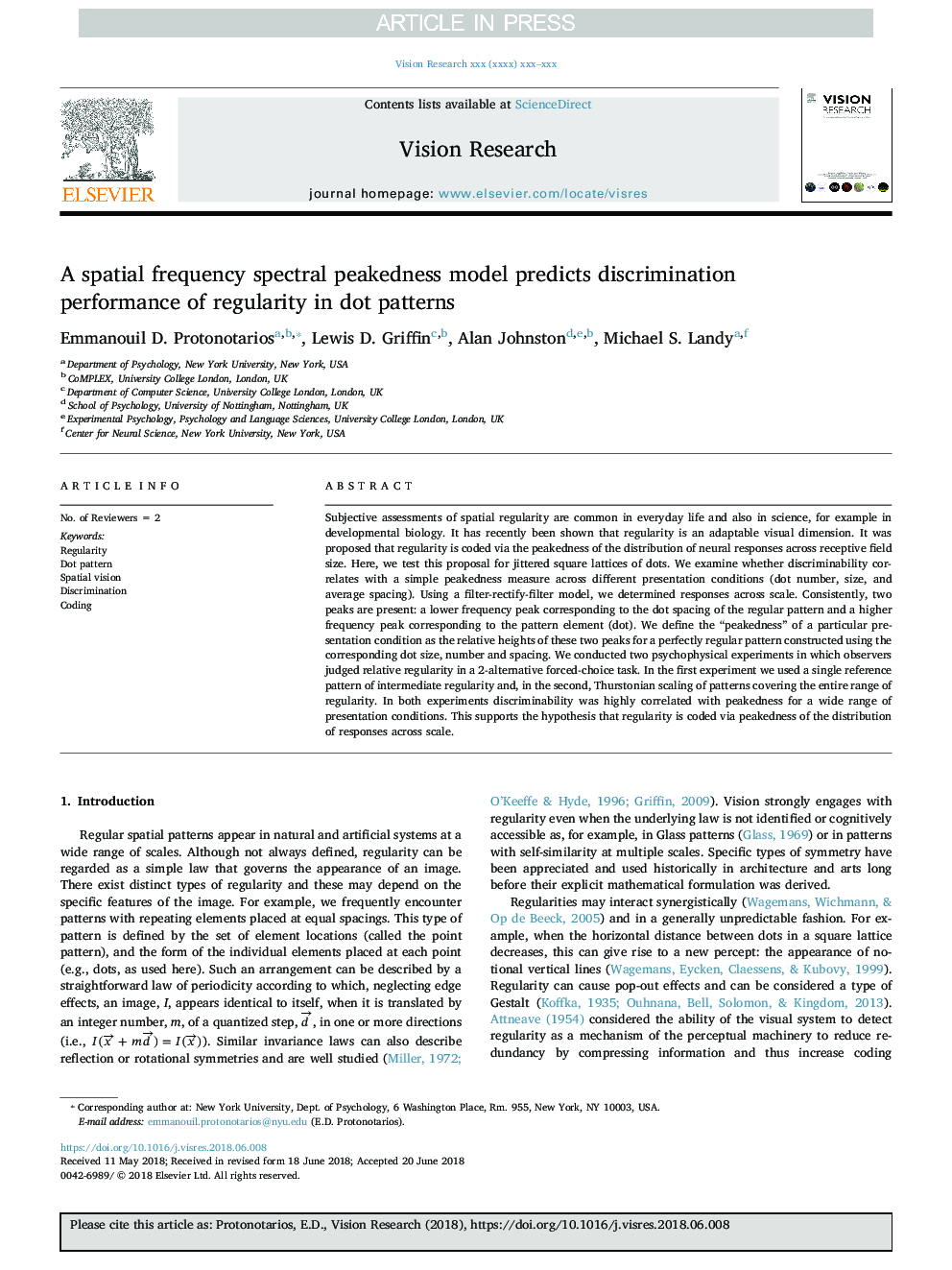| کد مقاله | کد نشریه | سال انتشار | مقاله انگلیسی | نسخه تمام متن |
|---|---|---|---|---|
| 8795289 | 1603151 | 2018 | 13 صفحه PDF | دانلود رایگان |
عنوان انگلیسی مقاله ISI
A spatial frequency spectral peakedness model predicts discrimination performance of regularity in dot patterns
ترجمه فارسی عنوان
یک مدل حداکثر طیف فرکانس فضایی پیش بینی عملکرد تبعیض منظم در الگوهای نقطه را پیش بینی می کند
دانلود مقاله + سفارش ترجمه
دانلود مقاله ISI انگلیسی
رایگان برای ایرانیان
کلمات کلیدی
ترجمه چکیده
ارزیابی های ذهنی از منظر فضایی در زندگی روزمره و همچنین در علم، به عنوان مثال در زیست شناسی توسعه، رایج است. به تازگی نشان داده شده است که منظم بودن ابعاد بصری سازگار است. پیش بینی شده است که منظم بودن از طریق ارزیابی توزیع پاسخ های عصبی بین اندازه میدان های پذیرنده کدگذاری شده است. در اینجا، این پیشنهاد را برای جرثقیل های مربعی جوت ها از نقطه ها تست می کنیم. ما بررسی می کنیم که آیا تبعیض پذیری با اندازه گیری صحیح ساده در شرایط مختلف ارائه (تعداد نقطه، اندازه و فاصله متوسط) همبستگی دارد. با استفاده از یک فیلتر فیلتر تصحیح فیلتر، پاسخ های ما در سراسر مقیاس را تعیین می کنیم. به طور مداوم، دو قله وجود دارد: یک پیک فرکانس پایین تر مربوط به فاصله نقطه ای از الگوی منظم و یک پیک فرکانس بالاتر که مربوط به عنصر الگو (نقطه) است. ما تعریف می کنیم؟ از یک وضعیت ارائه خاص به عنوان ارتفاع نسبی این دو قله برای یک الگوی کاملا منظم ساخته شده با استفاده از اندازه نقطه، تعداد و فاصله. ما دو آزمایش روان شناختی انجام دادیم که در آن ناظران به صورت منظم بودن نسبی در یک کار انتخابی مجاز 2 انتخاب شدند. در اولین آزمایش ما از یک الگوی مرجع تنها از منظر متوسط استفاده کردیم و، در مرحله دوم، پوسته پوسته شدن تریستون از الگوهایی که کل محدوده منظم را پوشش می دادند. در هر دو آزمایش، تبعیض پذیری به شدت با دامنه وسیعی از شرایط ارائه شده مرتبط بود. این از فرضیه حمایت می کند که منظم بودن از طریق ارزیابی توزیع پاسخ ها در سراسر مقیاس کدگذاری می شود.
موضوعات مرتبط
علوم زیستی و بیوفناوری
علم عصب شناسی
سیستم های حسی
چکیده انگلیسی
Subjective assessments of spatial regularity are common in everyday life and also in science, for example in developmental biology. It has recently been shown that regularity is an adaptable visual dimension. It was proposed that regularity is coded via the peakedness of the distribution of neural responses across receptive field size. Here, we test this proposal for jittered square lattices of dots. We examine whether discriminability correlates with a simple peakedness measure across different presentation conditions (dot number, size, and average spacing). Using a filter-rectify-filter model, we determined responses across scale. Consistently, two peaks are present: a lower frequency peak corresponding to the dot spacing of the regular pattern and a higher frequency peak corresponding to the pattern element (dot). We define the “peakedness” of a particular presentation condition as the relative heights of these two peaks for a perfectly regular pattern constructed using the corresponding dot size, number and spacing. We conducted two psychophysical experiments in which observers judged relative regularity in a 2-alternative forced-choice task. In the first experiment we used a single reference pattern of intermediate regularity and, in the second, Thurstonian scaling of patterns covering the entire range of regularity. In both experiments discriminability was highly correlated with peakedness for a wide range of presentation conditions. This supports the hypothesis that regularity is coded via peakedness of the distribution of responses across scale.
ناشر
Database: Elsevier - ScienceDirect (ساینس دایرکت)
Journal: Vision Research - Volume 149, August 2018, Pages 102-114
Journal: Vision Research - Volume 149, August 2018, Pages 102-114
نویسندگان
Emmanouil D. Protonotarios, Lewis D. Griffin, Alan Johnston, Michael S. Landy,
